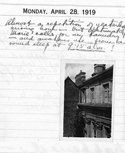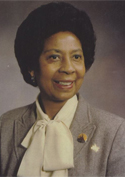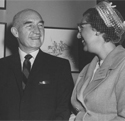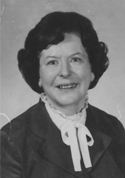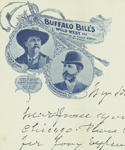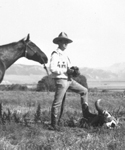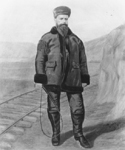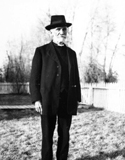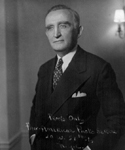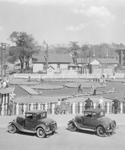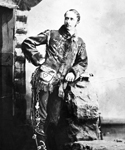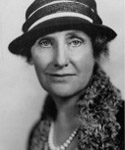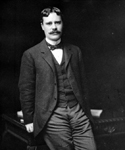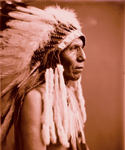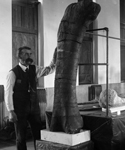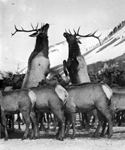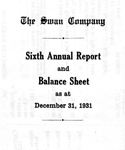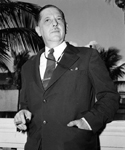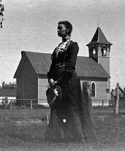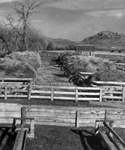Noteworthy Collections:
Edith K. O. Clark Diaries
Edith Kirkwood Ormsby Clark was Wyoming State Superintendent of Public Instruction from 1915 to 1919. She arrived in Wyoming in 1906 to visit her uncle, L.R.A. Condit. She took up a teaching position at the EK School in Johnson County and was elected county superintendent of schools for Sheridan County before moving to Cheyenne to take up a state level position. In 1918 she went to France to serve with the YMCA. After retiring from state government, she homesteaded in Johnson County. She died in 1936. Collection contains diaries created by Edith K.O. Clark from 1906-1924, 1931, and 1934-1936. In addition to a daily log of Clark's activities, the diaries contain photographs of people, churches, ranches, horses, hunting and camping trips.
Harriett Elizabeth Byrd Family Papers
Harriett Elizabeth Byrd was an educator who taught for 37 years in Wyoming. In 1981 she was elected to the Wyoming House of Representatives and then the Wyoming State Senate in 1988. Byrd was the first African-American legislator elected in Wyoming since its statehood in 1890. The collection consists of files, photographs, awards, certificates, and other memorabilia relating to Byrd's legislative and educational careers as well as her family.
League of Women Voters of Wyoming
The League of Women Voters was created at the final convention of the National American Woman Suffrage Association in 1920. Its main purpose at the time was to teach women how to use their new voting power. Since that time, the League of Women Voters in Wyoming has played an important role in helping to clarify election issues, get out the vote and sponsor non-partisan, major party debates. The records generally focus on Wyoming political contests; ballot access; fairness issues like apportionment, initiative, referendum, recall and balloting; planning annual conventions; and personal reminiscences which discuss how the League was formed in Wyoming.
Sheila Arnold papers
Sheila Arnold was a member of the Wyoming House of Representatives from 1978 to 1992. She was a Democrat whose platform included removing the sales tax on food, increasing the mineral severance tax, a long term water development program, and equalization of educational spending. While a State Legislator she was a member of the Joint Interim Mines, Minerals, Industrial Development Committee, Committee on Revenue, and the Committee on Rules and Procedures, the Governor's Council on Disabilities, and the Governor's Committee on Health Insurance.
Buffalo Bill Letters to George Beck
The Buffalo Bill letters consist of over 100 letters from the late 1890's and early 1900's to George T. Beck from William F. "Buffalo Bill" Cody concerning the operation of the Shoshone Irrigation Company and its water project. The entire collection has been digitized and is available online.
Charles J. Belden Photographs
Charles Belden was a well-known photographer who created some of the classic images of the American West, with most images captured on or near the Pitchfork Ranch in Northwest Wyoming. Also included are images from Belden's world travels. The entire collection of nearly 3,000 original negatives has been digitized.
John and Frances Casement Papers
John S. Casement was born in New York and came to Ohio in 1850 to work as a railroad construction foreman. After service in the Civil War, Casement obtained a contract to perform tracklaying and grading for the Union Pacific's transcontinental line. The papers primarily consist of correspondence during the time Casement was constructing the Union Pacific Railroad from Omaha to Promontory Point, Utah, from 1866 to 1869. The first five series in the collection have been digitized.
John Roberts Papers
John Roberts was an Episcopalian missionary who worked among the Arapaho and Shoshone peoples on the Wind River Indian Reservation in Wyoming. All photographs and Arapaho and Shoshone of Christian and Episcopalian texts have been digitized, in addition to most of his personal papers.
Joseph C. O'Mahoney Papers
O’Mahoney was a prominent Wyoming lawyer and politician who was appointed to fill the Senate vacancy created by the death of Senator Kendrick, and ending up serving as Senator for 25 years between 1933 and 1960. The online collection includes O'Mahoneys speeches as well as photographs from the collection.
Ludwig-Svenson Studio Collection
Henning Svenson settled in Laramie in 1905 and became the primary commercial and studio photographer in the town. He was known for his portraiture of Laramie residents and scenes of the surrounding area including Laramie, the Snowy Range, Fox Park, Happy Jack, and Sand Creek. Nearly 4,000 negatives from the early years of the studio have been digitized.
Moreton Frewen Papers
Moreton Frewen formed the Big Horn Ranch Company in the late 1870s and operated a cattle ranch in what is now northeastern Wyoming. In 1882 the company was dissolved after Frewen reorganized the company as the Powder River Cattle Company. The company was dissolved in 1889 due to overstocked pastures and harsh winters. The digitized collections includes business records, legal records, correspondence, and photographs.
Nellie Tayloe Ross Papers
Nellie Tayloe Ross was the first woman governor in the United States. Her husband, William B. Ross, was elected Governor of Wyoming in 1922. Three weeks before election day in 1924, William B. Ross died and Nellie Tayloe Ross was elected in his stead. She was appointed Director of the U.S. Mint in 1933 by President Franklin D. Roosevelt and served in that capacity until her retirement in 1953. Over 5,000 items - primarily speeches, correspondence, photographs, and audio/video material - have been digitized.
Owen Wister Papers
This collection includes journals, manuscripts, photographs, articles, publications, and correspondence. These materials document the life and literary career of Owen Wister. The digitized journals, manuscripts, and photographs in this collection deal primarily with his interest in the American West and the literary works that he developed from these travels.
Richard Throssel Photographs
Collection contains materials mainly relating to Throssel's photographic work of the Crow and Northern Cheyenne Indians from 1902-1933. The digital collection includes about one-fifth of the 2,481 glass plate negatives and lantern slides Throssel produced, which document Crow and Northern Cheyenne culture, what is now the Little Bighorn National Monument, daily life of Billings, Throssel and his family, ranching, and scenery of southern Montana and northern Wyoming.
Samuel H. Knight Papers
The S.H. Knight collection documents the University of Wyoming's history and Knight's career as a geologist and University of Wyoming professor. His digitized photographs document UW's history and show buildings, landscapes, students, faculty, and activities.
S. N. Leek Papers
Leek was a hunter, trapper, dude rancher, politician, and guide as well as a writer and wildlife photographer. He was also one of the earliest settlers in Jackson Hole, Wyoming. The digital collection is comprised of his photographs, which depict wildlife (especially elk) and natural areas around Jackson Hole.
Swan Company Records
In 1883 the Swan Land & Cattle Co. was organized and acquired land near the site of Chugwater, Wyoming. The company owned several ranches throughout the southeast corner of the state of Wyoming and leased land from several other ranches in the area for grazing purposes for the cattle and sheep they raised. The digitized collection includes correspondence, financial records, and photographs.
Thurman Wesley Arnold Papers
Thurman Wesley Arnold practiced law in Laramie, Wyoming, and served as Mayor from 1923 to 1924. He was named assistant attorney general of the U.S. in charge of the antitrust division in 1938 and was a Department of Justice representative on the Temporary National Economic Committee from 1938 to 1941. The digital collection includes speeches, correspondence, draft manuscripts, and photographs.
W. B. D. and Annette Gray Papers
W.B.D. and Annette B. Gray were Congregational missionaries to the people of Wyoming from 1900 to 1918. The couple’s missionary work was supported by slide lectures given to audiences in the East on conditions in Wyoming. For this purpose they took many photographs, all of which have been digitized, of small communities and rural areas of the state, which were exhibited during winter visits to Boston and other eastern cities.
Wyoming Stock Grower's Association Records
The Stock Association of Laramie County was organized in Cheyenne in 1872. It was involved in a broad range of activities, including managing roundups, conducting brand inspections, and dealing with health and sanitary concerns, freight rates, and fencing and other public domain issues. The Association was instrumental in the development of Wyoming livestock and rangeland laws beginning in the 1880s and was closely involved in the Johnson County War of 1892. The digital collection includes photographs and administrative records.

